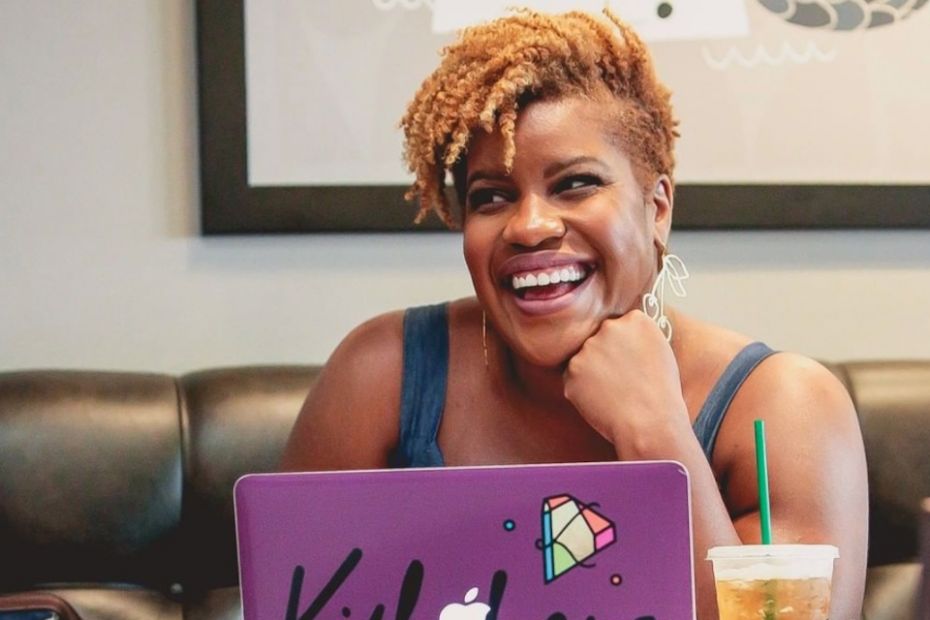Building a team and empowering leaders is not easy.
Doing so virtually in a remote work environment is even more of a challenge. For all the leadership guides out there, it's clear that inclusive leadership requires intention and a certain mindset to do it well. While we don't know what the future holds, remote work and virtual engagement are here to stay.
We spoke to Kishshana Palmer, Leadership Strategist, Speaker, and Coach, about what it means to support leadership and diversity and inclusion in a virtual environment.
Kishshana knows leadership.
Before starting
Kishshana &Co., a boutique consulting firm, she immediately began executive leadership following grad school. Talk about boss moves! As a young professional in a leadership role responsible for budget, strategy, and managing people, Kishshana brings not only a unique perspective but a commitment to the development and rise of entrepreneurs and career professionals.
If you are a founder or a rising leader, read on for the strategies and insights you need to know as you create your dream team rooted in equity and inclusion, regardless of location or size.
Why is leadership development so important?
People are your #1 asset. It doesn't matter about your industry, mission, or services. Businesses that make it their business to
prioritize their people are better places to work. They are the places where there's innovation; people feel joy and can bring their fullest selves to show up as humans.
Many of us spend a lot of time in the workplace (or doing work-related tasks)—usually more than at home! If you're going to spend most of your day, your week, or your adult working life at work, you must
take good care of yourself.
We often see individual contributors promoted to people management. Usually, it's the first time and without the proper preparation. As an individual contributor now in management and leadership, it makes sense to understand how people work. You have the responsibility to move people from path to goal. That's major!
Whether you are a leader or an employee, the foundation of any
leadership development program is trust. Adopting a holistic approach that respects whole people, framework, and connection is a must. If you don't understand how people show up at work or
how people communicate and connect, you will not have a great leadership experience.
How do diversity, equity, and inclusion (DEI) tie into leadership?
When you think about the banners of leadership, it helps to set a vision, inspire people to action, and chart a course for others to follow. There is a need to have a diversified group. Studies have shown time and time again that diverse teams get it done faster, have more innovation, help companies bring in more revenue, raise more money, and run more efficiently.
So, when you focus on
diversifying your team, you focus on making sure that your team is equitable. An equitable team means everybody gets a turn. Everybody gets an opportunity to experience decision-making veto, lead projects, and have a voice and autonomy on how to get it done. More than that, when embedding DEI, you must look at everything.
More than policies or what's written on paper, what is the state of culture? How are projects assigned? What is the decision-making structure? The reason to approach it this way is if you do not embed DEI into the way you do business, then it becomes a fad instead of a foundational staple.
This past year, there have been more conversations, more pushback, and more response to the idea that we need more diverse talent, specifically Black and brown talent. But I always say this: if the money ain't on it, I don't want it.
If you are not tying the outcomes of embedding DEI into your company fabric, your revenue drivers, and it does not attach to compensation or resources, it's a waste of time.
Leaders must ask how far they're willing to go and ensure that DEI becomes a part of their foundation's bedrock. Even if you have to dig up that foundation.
What makes a virtual or remote environment unique? What should leaders consider when creating an inclusive environment among a distributed workforce?
One of the things that stand out is that some company policies, practices, and procedures reflect laziness.
At any level, DEI requires taking the step to customize the experience of different team members across different cultural, ethnic, and racial groups. Think of the instances where lack of inclusion showed up in company activities, mixers, and retreats. If this was already a challenge in person, it's harder to have a strong team culture that is virtual and
inclusive.
The second thing is that home is a place of safety for many. For instance, if your employees had to put on a different version of themselves to navigate corporate, nonprofit, or government workspaces, then home was the place not to do that. Home was a place of both physical and psychological safety.
With virtual teams, we are inviting all the folks into our living room into our personal spaces. So, for managers, particularly organizational leaders, to honor that home is supposed to be a private and safe space, we must be vigilant about the types of working norms and boundaries we put in place to protect people's safe spaces.
And that can be having hard stop times on meetings or no meeting Fridays. The point is that if you are a people manager right now, you need to include team members' lived experience in your projections. You must leverage that information so you can make better decisions for your people.
What practices should leaders AVOID when trying to advance diversity and inclusion at the leadership level?
First things first, leaders need to ban the phrase "in the interest of time." From this day on, ban this phrase forever. Here's why. Time is often a proxy for urgency and is used to keep folks out of the decision-making circle. If we're thinking about leadership 2.0 being virtual with DEI as the foundation, then we must remove the preference of time over inclusion and add more voices to the table.
A second way that I see managers and leaders trip over themselves is not admitting when they don't know something or are unsure. Right now, there's a general practice of not allowing failure or failing fast to be a part of the ruling norms of the day. DEI, especially in leadership, requires experimenting, adjusting, and moving on if we need to.
The other practice to avoid is not taking time to build relationships. Usually, it's because we don't want to get too personal. However, I would argue that to be
an effective leader, mainly if you are a day-to-day people manager, you must be professional AND personal. You can have effective personal relationships with your team without delving into private matters.
The ability to collaborate has shifted from being only about skill and competency to having a connection to understand levels of performance.
What final advice do you have for leaders, startup founders, and career professionals who strive to be intentional about creating community virtually?
Being able to get clear on my values and understanding how those translate to my company values was critical in attracting people who wanted to work with
Kishshana & Co. I didn't start out saying I wanted all these folks. It was about feeding my child as a solo mama who left my job. So, I don't want to dilute people and things like I started with this idea of community.
I started with a level of authenticity rooted in integrity and funding creativity that ultimately manifested the community.
Whether you are a team of five or are in your bedroom working on your new business right now or are preparing for your second round of venture funding, make sure that you're clear on your values and how they translate to your company values. This will attract the type of people who will follow you wherever you want to go.
Community is not about money. The money will come. But if you do not have values that your company, your startup that your solopreneur business or freelancing business sits on, then it's going to be hard to know who really should be in the room and who shouldn't be in the room with you.
To keep up with Kishshana and her continuing quest to get folks C-Suite ready, please visit
Kishshanaco.com and follow her on social media
@KishshanaPalmer.










